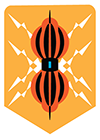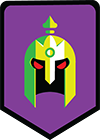Inspiration
It has been a long-time dream of mine to illustrate some part of the great Kurukshetra war features so prominently in the Indian epic Mahabharata.
The war, which takes place over a span of 18 days, covers nearly one-third of the entire epic and yields in-depth details about the preparations for the war, the big players, the battle formations and the epic encounters.
Chief amongst my fascinations were the banners that flew atop each hero's chariot, sort of like a pirate ship or naval armada flying their colors of allegiance.
The second angle of my fascination comes from my love of strategy videogames such as Age of Empires 2, Heroes of Might and Magic 3 and Warcraft 3, which represent giant armies from a top-down view.
The third inspiration came from the descriptions of the armies in the Mahabharata. The text goes into detail explaining that the units of warfare such as the Footman (Padha), Horseman (Ashwa), Chariot (Ratha) and Elephant (Gaja) formed the foundation of the strategy game Chaturanga which later evolved into the modern game of Chess.
The last part of my inspiration came from a visit to the German History Museum here in Berlin, where I saw a shield that was presented to the King, painted with the various sigils of the houses that stood in support of his rule.
And with this final piece of inspiration in hand, I set off with my drawing.
Research
I spent a lot of time researching the heroes, their banners, their armies and the various battle formations they employed. There were some cases where I just wasn't able to find any specifics and had to take a bit of artistic license in interpreting the information. Here's what I found:
The Kurukshetra war was fought between the forces of the Pandavas (5 brothers, sons of Pandu) and the Kauravas (100 brothers, sons of Dritharashtra) over a dispute of who had the right to rule the kingdom.
The sizes of the armies were measured in a unit called an Akshauhini, which consisted of a combination of forces in the ratio 1 Elephant: 1 Chariot: 3 Horsemen: 5 Footmen multiplied by a factor of 21870
The skill level of a warrior was scaled as follows: Rathi (capable of fighting 5000 warriors at once), Athirathi (capable of fighting 12 Rathis or 60000 warriors), Maharathi (capable of fighting 12 Athirathis or 720000 warriors)
The Pandava army was composed of 7 Akshauhinis
The Kaurava army was composed of 11 Akshauhinis
The Story
Despite being massively outnumbered, the Pandava army has a secret weapon who goes by the name of Arjuna. This Pandava warrior is clearly the hero of the war. He features prominently in a vast portion of the battles and rallies everyone behind him with his feats of skill in warfare.
After 12 days of intense bloodshed, the realize that the best way to end the war swiftly is to distract Arjuna and capture the eldest Pandava brother Yudhistira. And so they enlist the aid of the Samsapthaka armies of Trigartha and the Narayani Sena of the Yadavas to challenge Arjuna and drag him out to a remote part of the battlefield. The Kaurava commander-in-chief Dronacharya, then employs the Chakravyuha or the Wheel battle formation, since it was rumored that only Arjuna knew the secret of entering and breaking it.
The confounded and desperate Pandava forces first try a counter-attack through the Crescent Moon formation but then turn to Arjuna's young son Abhimanyu, who knew the secret of entering the Chakravyuha but knew not how to exit or break the formation. With strong reassurances from the other Pandava heroes that they would follow him and give him support, Abhimanyu set forth entering the maze-like rotating wheel formation.
However, the Pandava forces are halted by the insurmountable defense of Jayadratha, the king from Sindh, and are unable to follow the young prince.
Trapped away from his army and with no escape route in sight, Abhimanyu strengthens his resolve and goes on a rampage, defeating many enemy heroes and decimating a vast array of Kaurava forces. In the end, feeling like they set a trap for a kitten and caught a lion instead, the desperate Kaurava forces surround Abhimanyu on all sides, abandon all rules of chivalrous warfare and succeed in killing him.
There are three direct consequences to this:
- All the rules of chivalry and ethics of warfare are completely abandoned
- The death of Abhimanyu spurs the noble Pandavas onward to finish the fight by any means necessary
- It sets up an even more epic 14th day of battle, with Arjuna swearing a terrible oath to kill Jayadratha or end his own life
Philosophy of the Formations
The Moon has very many symbolic meanings in different cultures of the world. The Waning Moon represents surrender, contemplation and meditation. The New Moon represents new beginnings and rebirth. The Waxing Moon represents growth and manifestation. The Full Moon represents clarity and fulfillment.
In this case, the crescent moon takes on a very special meaning. Having two tips, it could represent for the Pandavas, a lack of desire to tackle their problem head-on and instead trying to circumvent it somehow. They were always hesitant about fighting with their cousins, relatives and teachers, and constantly doubting whether they were doing the right thing. This strong desire to avoid the primary conflict led to the death of Abhimanyu, which in turn had a dramatic impact on the course of the battle as well as the formation used by the Pandavas the very next day.
The Kauravas on the other hand, utilized the Chakravyuha or an ever-twisting snake-like circular maze formation. The ancient Egyptian and Greek philosophers viewed the world as a constant cycle of life-death, creation-destruction and imagined it as an Ouroboros, the snake swallowing its own tail. In Alchemy, the Ouroboros is associated with the Philosopher's Stone, which is said to hold the secret to immortal life. In Norse mythology, this takes the form of the world-snake Jörmungandr, which grew so large that it could encircle the entire world and hold its tail between its teeth. Jörmungandr was also foretold to bring about Ragnorok, or the end of the world and the destruction of the Gods. In Vedic philosophies, it is believed that the power of the Kundalini lies coiled like a snake holding its own tail.
This symbolism could be taken to imply that the Kauravas strongly believed that they were going to bring about the destruction of the God-like Pandavas and award themselves eternal glory by winning this battle.
Pandava Forces
Kaurava Forces
The End Result






































